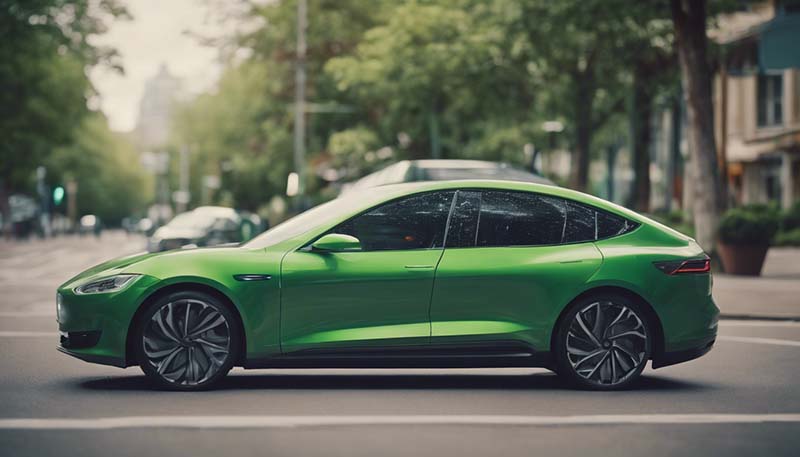Green Tech: The Most Innovative Electric Car Technologies
Welcome to the era of electric vehicles (EVs), where innovation is the driving force behind the automotive industry's shift towards sustainability. As the world moves towards a greener future, electric car technologies are evolving at an unprecedented pace. This article delves into the most innovative electric car technologies that are shaping the future of transportation.
Battery Technology
The heart of any electric car is its battery. The quest for longer ranges and shorter charging times has led to significant advancements in battery technology.
Solid-State Batteries
Solid-state batteries are poised to revolutionize the EV market. Unlike conventional lithium-ion batteries, which use a liquid electrolyte, solid-state batteries use a solid electrolyte. This promises higher energy density, faster charging times, and improved safety.
Battery Life Extension
Technological advancements are also being made to extend the life of EV batteries. Through predictive maintenance and improved battery management systems, the longevity of batteries is being enhanced, reducing the need for replacement and the environmental impact of battery disposal.
Advertisement
Charging Infrastructure
The widespread adoption of EVs is heavily dependent on the availability of charging infrastructure.
Ultra-Fast Charging
Ultra-fast charging stations are being developed to charge EVs in a fraction of the time it currently takes. These high-powered charging points can recharge a battery to 80% in as little as 20 minutes.
Wireless Charging
Wireless, or inductive, charging is an innovative technology that allows EVs to charge without the need for cables. This technology uses magnetic fields to transfer energy between the charging pad and the vehicle's battery, offering a more convenient charging experience.
Lightweight Materials
Reducing the weight of vehicles is a key strategy for improving efficiency and range.
Carbon Fiber and Advanced Composites
Carbon fiber and other advanced composite materials are being used to create lighter and stronger vehicle parts. These materials can significantly reduce the overall weight of an EV without compromising safety or performance.
Aluminum Body Frames
Aluminum is lighter than steel and is increasingly being used in vehicle construction to reduce weight. Electric cars with aluminum body frames can achieve better range and improved handling.
Regenerative Braking Systems
Regenerative braking systems convert the kinetic energy lost during braking back into electrical energy, which is then stored in the battery.
Advanced Regenerative Braking
Newer systems offer more sophisticated regenerative braking, allowing drivers to recover more energy and even customize the braking response to their driving style.
Vehicle-to-Everything (V2X) Communication
V2X communication refers to the exchange of information between a vehicle and any entity that could affect it, including other vehicles, infrastructure, pedestrians, and even the internet.
Smart Grid Integration
EVs are becoming an integral part of the smart grid, allowing for two-way communication between the vehicle and the power grid. This enables load balancing, peak shaving, and the ability to use the EV battery as a temporary energy storage unit.
Autonomous Driving
While not exclusive to EVs, autonomous driving technology is often paired with electric powertrains. Self-driving EVs can optimize energy use through efficient routing and driving habits, further enhancing the sustainability of transportation.

Energy-Efficient Heating and Cooling Systems
One of the challenges with EVs is maintaining a comfortable cabin temperature without consuming excessive amounts of energy.
Heat Pump Technology
Heat pump technology is being adapted for use in EVs to provide efficient heating and cooling. Heat pumps can extract heat from the outside air, even in cold temperatures, and use it to warm the cabin, reducing the load on the battery.
Thermal Management Systems
Advanced thermal management systems are crucial for maintaining battery and cabin temperatures. These systems use phase-change materials and sophisticated cooling channels to optimize energy use and extend battery life.
Aerodynamic Design
Improving aerodynamics is a key factor in increasing the range of EVs.
Active Aerodynamics
Active aerodynamic components, such as adjustable spoilers and diffusers, can be used to improve the airflow around the vehicle, reducing drag and improving efficiency.
Airless Tires
Airless tires, which rely on a unique structure rather than air pressure to support the vehicle's weight, can reduce rolling resistance and improve overall efficiency, while also eliminating the risk of punctures.
Conclusion
The future of electric cars is bright, with innovations in battery technology, charging infrastructure, lightweight materials, regenerative braking, V2X communication, energy-efficient systems, and aerodynamics all contributing to more efficient, longer-range, and smarter vehicles. As these technologies continue to develop, the appeal of EVs will only grow, paving the way for a more sustainable and connected world.
Comment Box